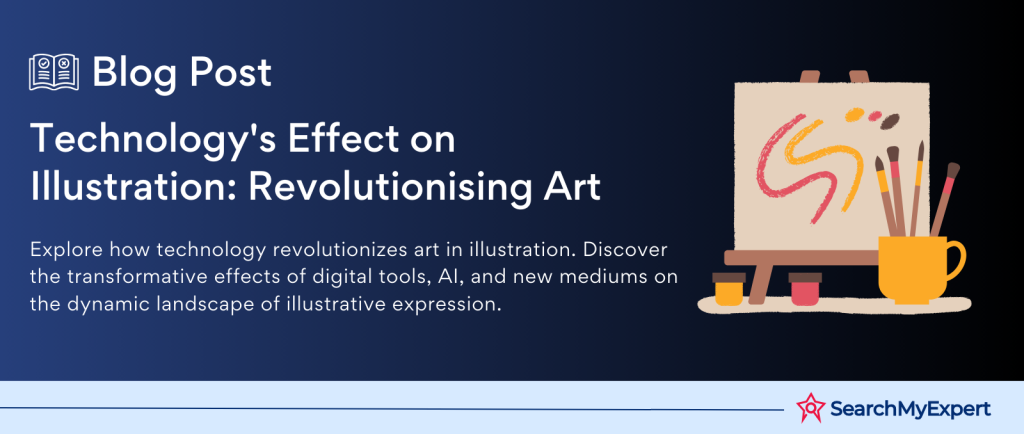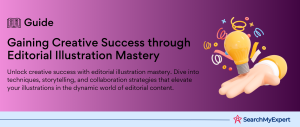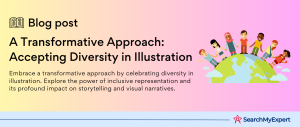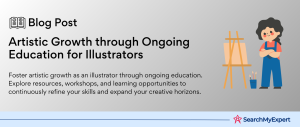The Impact of Technology on Illustration
Illustration: A Canvas of History and Creativity
Illustration, a vibrant art form, has journeyed through centuries, mirroring cultural and societal transformations. From cave paintings to intricate medieval manuscripts, its historical significance is profound. Illustration has always been more than just art; it’s a storytelling medium, conveying ideas and narratives with visual allure.
Technological Revolution: Redefining the Creative Landscape
Enter the era of technology, and the domain of illustration undergoes a seismic shift. This fusion of tech and art is not just a change; it’s a revolution. Technology has woven itself into the fabric of creative expression, introducing tools and platforms that have transformed how artists conceive and execute their ideas.
A Glimpse into the Future: Where Technology Meets Art
As we peek into the key areas where technology impacts illustration, expect a kaleidoscope of changes:
- Digital Tools:
Empowering artists with unprecedented precision and versatility. - 3D Modeling: Blurring the lines between two-dimensional and spatial art.
- AI and Machine Learning: Unveiling new horizons in automated and generative art.
- Online Platforms: Bridging the gap between artists and global audiences.
The intersection of technology and illustration is not just a meeting point; it’s a launchpad into a realm of boundless possibilities. Let’s embark on this journey to explore how technology is reshaping the art of illustration, turning every pixel and digital stroke into a testament to this dynamic era.
Transformation of Tools and Techniques
From Canvas to Pixels: The Digital Shift
Gone are the days when an artist’s arsenal was limited to paint, pencils, and brushes. The digital age ushered in a seismic shift, redefining the illustrator’s toolkit. This transition from canvas to screen isn’t just a change of medium; it’s a complete overhaul of the creative process.
The Digital Toolbox: A Spectrum of Possibilities
Illustrators today wield an impressive array of digital tools:
- Drawing Tablets:
The bridge between the hand and the screen, offering a natural drawing experience. - Vector Programs:
From Adobe Illustrator to CorelDRAW, these programs allow for crisp, scalable artwork. - 3D Software: Tools like Blender and Maya add a new dimension, quite literally, to illustration.
- Image Editors: Photoshop and its ilk, perfect for detailed editing and compositing.
Each tool opens new avenues, enabling artists to push boundaries and explore uncharted creative territories.
Advantages of Going Digital
The digital realm offers illustrators unprecedented advantages:
- Flexibility: Infinite undo’s and easy alterations.
- Efficiency: Streamlined workflow and faster turnaround times.
- Creative Freedom:
Experimentation without the fear of wasting materials. - Global Reach:
Share and collaborate with a worldwide community.
Digital tools have not only transformed how illustrations are created but have also expanded what is possible within the art form. They enable illustrators to venture into realms beyond the reach of traditional materials, making the impossible possible.
Redefining Artistic Boundaries
Expanding the Palette: New Visual Languages and Styles
Technology has not just changed the tools illustrators use; it has revolutionized the very language of art. Digital platforms offer a plethora of styles and techniques that were previously unimaginable. From hyper-realistic digital paintings to abstract vector art, the range is staggering. This expansion has empowered artists to explore and invent unique visual languages, breaking free from the constraints of traditional media.
The Frontier of Tech: Augmented Reality and Artificial Intelligence
In the forefront of this artistic revolution are concepts like Augmented Reality (AR) and Artificial Intelligence (AI):
- Augmented Reality:
AR blurs the lines between the real and the virtual, allowing illustrators to bring their creations to life in the physical world. - Artificial Intelligence: AI in illustration goes beyond mere tool usage. It’s about collaboration with algorithms, resulting in generative art that’s both intriguing and unpredictable.
These technologies are not just tools; they are collaborators, opening doors to realms previously inaccessible to human artists alone.
Hybrid Expressions: Melding the Traditional with the Digital
Perhaps the most exciting development is the merging of traditional and digital art forms. This fusion has given birth to hybrid artistic expressions, where the tactile texture of physical media meets the limitless potential of digital techniques. It’s a symbiotic relationship, each enhancing the other, leading to artworks that are rich, diverse, and multi-dimensional.
The boundaries of what can be considered ‘illustration’ are constantly being pushed, redefined, and blurred, leading to a dynamic, ever-evolving art form.
Democratization of the Artform
Lowering Barriers: Access for All
The advent of technology has democratized illustration, making it more accessible than ever before. Gone are the days when the field was gated by the need for expensive materials or exclusive education. Digital tools and software, often free or affordable, have lowered the entry barriers significantly, enabling anyone with a passion for art to dive in.
Online Platforms: Nurturing Talent and Community
The internet is rife with platforms and resources that nurture aspiring illustrators:
- Educational Resources: Websites like Skillshare and Udemy offer a plethora of courses, catering to all skill levels.
- Community Forums: Platforms like DeviantArt and Behance not only allow artists to showcase their work but also to engage with a community, exchange feedback, and grow.
- Open-Source Tools: Software like GIMP and Krita provide free, high-quality tools for digital illustration.
These online spaces are not just learning hubs; they are incubators for talent and creativity.
Social Media: A Global Stage
Social media has transformed the way illustrators showcase and promote their work. Platforms like Instagram, Twitter, and Pinterest have become digital galleries, where artists can reach a global audience instantly. This exposure not only opens doors to new opportunities but also allows for real-time engagement with audiences, a luxury that was previously unattainable for many artists.
Technology, in essence, has turned illustration from an elite art form into a global, inclusive community, where anyone can participate, learn, and shine.
Commercial and Industrial Impact
Technology’s Influence on the Illustration Industry
The illustration industry, encompassing publishing, advertising, and animation, has been profoundly transformed by technology. Digital tools have revolutionized the production process, making it faster and more efficient. Publishers now favor digital artwork for its ease of editing and reproduction. In advertising, digital illustrations allow for rapid prototyping and testing of concepts, while in animation, technologies like CGI have opened up new dimensions of storytelling.
New Avenues: Online Platforms, E-Commerce, and Digital Media
The rise of online platforms and digital media has created new opportunities for illustrators:
- Online Marketplaces: Websites like Etsy and Society6 have allowed artists to sell their work directly to consumers, bypassing traditional channels.
- Freelancing Platforms: Sites like Fiverr and Upwork provide a global stage for illustrators to offer their services.
- Digital Publications: The growth of digital magazines and online content has expanded the market for digital illustrations exponentially.
These avenues not only offer financial opportunities but also enhance visibility and reach for artists.
Evolving Client Expectations
With the advent of digital tools, clients now expect a higher level of innovation in visual storytelling. The demand for unique, engaging, and interactive illustrations is at an all-time high. This shift has pushed illustrators to continually evolve their skills and embrace new technologies to meet these changing demands.
Ethical Considerations and Challenges
Navigating the Minefield of Copyright and Plagiarism
The digital age, while bringing numerous advantages, also poses significant challenges in terms of copyright infringement and plagiarism. The ease of copying and distributing digital works has led to a rise in unauthorized use, making it increasingly difficult for artists to protect their intellectual property. These concerns underscore the need for robust digital rights management and ethical practices within the community.
Automation’s Double-Edged Sword: Opportunity and Obsolescence
Automation and AI in illustration present a paradoxical scenario. On one hand, they offer tools that can enhance creativity and efficiency. On the other, there’s a looming threat to traditional artistic jobs. This shift necessitates a rethinking of the illustrator’s role, emphasizing the need for continuous learning and adaptation to new tools and technologies.
The Authenticity Debate in Digital Art
Digital art has sparked a debate over what constitutes ‘authentic’ art. Critics argue that the ease of manipulation and the use of automated tools can diminish the artist’s direct involvement in the creative process. However, proponents of digital art advocate that creativity and vision remain at the heart of all artistic endeavors, regardless of the medium. This debate highlights the ongoing evolution of our understanding of art and the artist’s role in the age of digital technology.
A New Era for Illustration
As we’ve journeyed through the myriad ways in which technology has impacted illustration, one thing is clear: we are witnessing the dawn of a new era in this art form. From the transformation of tools and techniques to the democratization and commercialization of the artform, technology has played a pivotal role. It has not only redefined the boundaries of creativity but also introduced ethical considerations and challenges that urge us to think and act conscientiously.
An Optimistic Glimpse into the Future
Looking ahead, the future of illustration in a technology-driven world is bright and promising. The continual advancements in digital tools and platforms are opening doors to unexplored artistic possibilities. As technology evolves, so too will the scope and depth of illustration, offering new avenues for expression and storytelling.
A Call to Further Exploration and Discussion
This evolving relationship between technology and art is not just a topic for contemplation but an invitation for active participation. Whether you are an artist, a tech enthusiast, or a curious observer, there is a place for you in this conversation. The future of illustration, shaped by the interplay of art and technology, is a collaborative narrative waiting to be written by all who dare to imagine and create.
Conclusion
The journey of illustration through the digital age is both transformative and expansive. Technology has not only reshaped the tools and techniques of artists but also broadened the horizons of what can be achieved in this art form. From the democratization of illustration, making it accessible to a wider audience, to the emergence of new commercial and ethical landscapes, the impact is profound. As we look to the future, the field of illustration stands at a promising crossroads, rich with potential and driven by continuous innovation. The fusion of art and technology is an ongoing narrative, one that promises to keep evolving, inspiring, and challenging the traditional confines of illustration.
Forge a distinct visual identity with Illustrators Firms.
Table of Contents
Toggle






